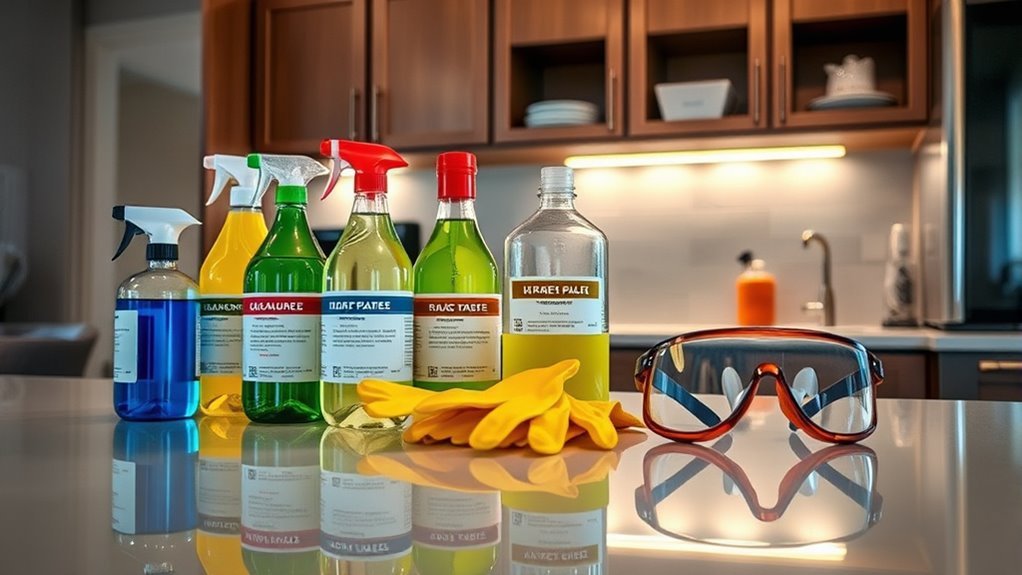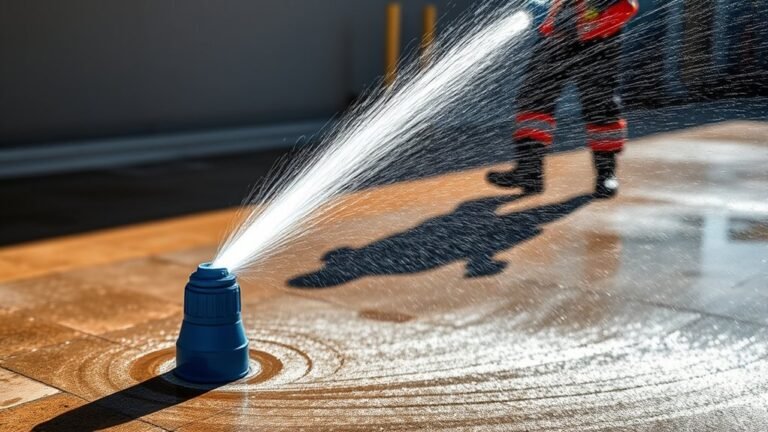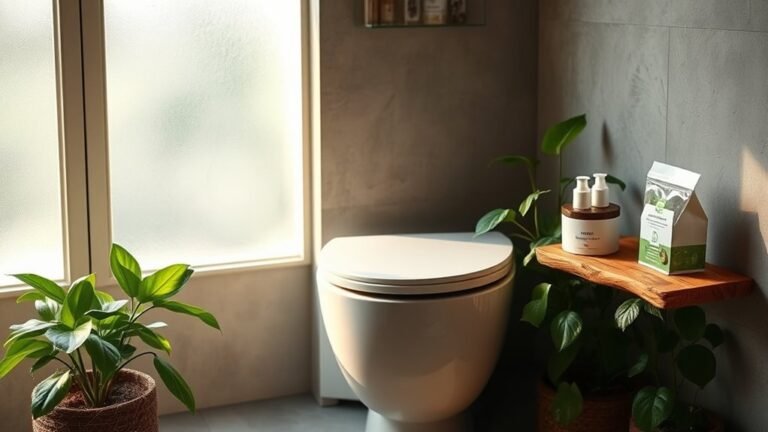So reinigen und lagern Sie gefährliche Reinigungschemikalien
You should always wear gloves, goggles, and a respirator to protect yourself when handling hazardous cleaning chemicals. Clean spills immediately using absorbent materials and ventilate the area well. Store chemicals in sturdy, clearly labeled containers away from incompatible substances like acids and bases to prevent reactions. Keep them in a cool, dry, well-ventilated space with secure lids to avoid leaks. Following these steps guarantees safety, and understanding more can help you handle chemicals like a pro.
Understanding Different Types of Hazardous Cleaning Chemicals
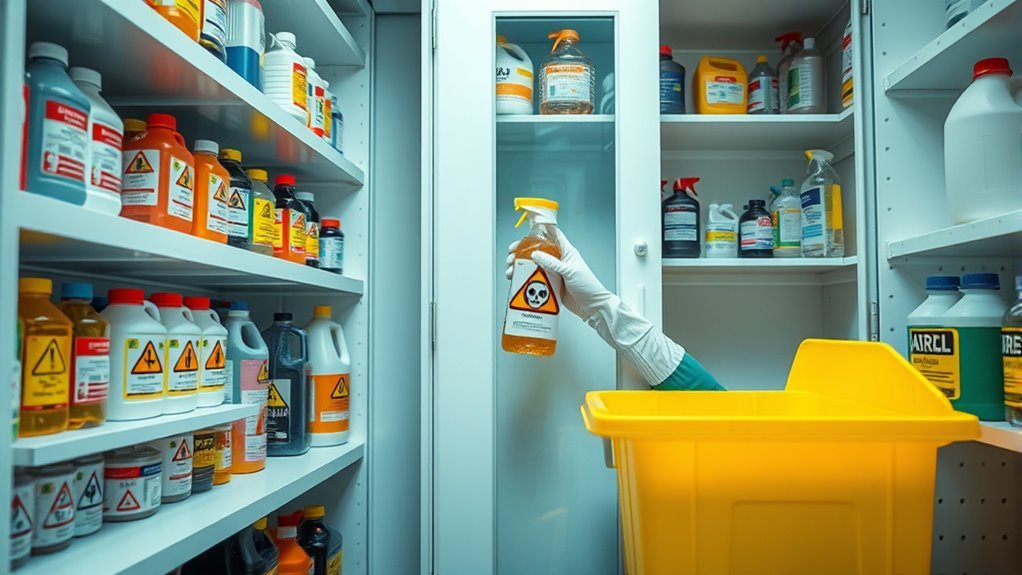
Before you begin cleaning, it’s important to understand the different types of hazardous chemicals you might encounter. These cleaning agents can vary widely, so knowing their chemical classifications helps you handle them safely and confidently. Some are corrosive, like strong acids or alkalis, which can cause burns. Others might be flammable or reactive, posing fire risks if mishandled. There are also toxic agents that release harmful fumes or cause health issues upon exposure. By recognizing these categories, you gain the freedom to clean efficiently without unnecessary risks. This knowledge empowers you to make smart choices about how you use and store each chemical, keeping yourself and others safe while maintaining control over your environment. Understanding chemical classifications is your first step to mastering hazardous cleaning agents.
Personal Protective Equipment for Handling Chemicals
Protective gear is essential when handling hazardous cleaning chemicals to prevent injuries and exposure. You want to stay safe without feeling restricted, so choosing the right personal protective equipment (PPE) is vital. Gloves, goggles, and aprons shield you from chemical exposure, while respirators protect your lungs from harmful fumes. Don’t skip safety training—it teaches you how to properly wear and maintain PPE, ensuring maximum protection. Remember, freedom means knowing you’re protected, not risking your health. By embracing PPE with confidence, you keep control over your safety and the environment around you. Always check your gear before use, and replace any damaged items to maintain that essential barrier between you and hazardous chemicals. Staying prepared means staying free.
Steps to Safely Clean Up After Using Hazardous Chemicals
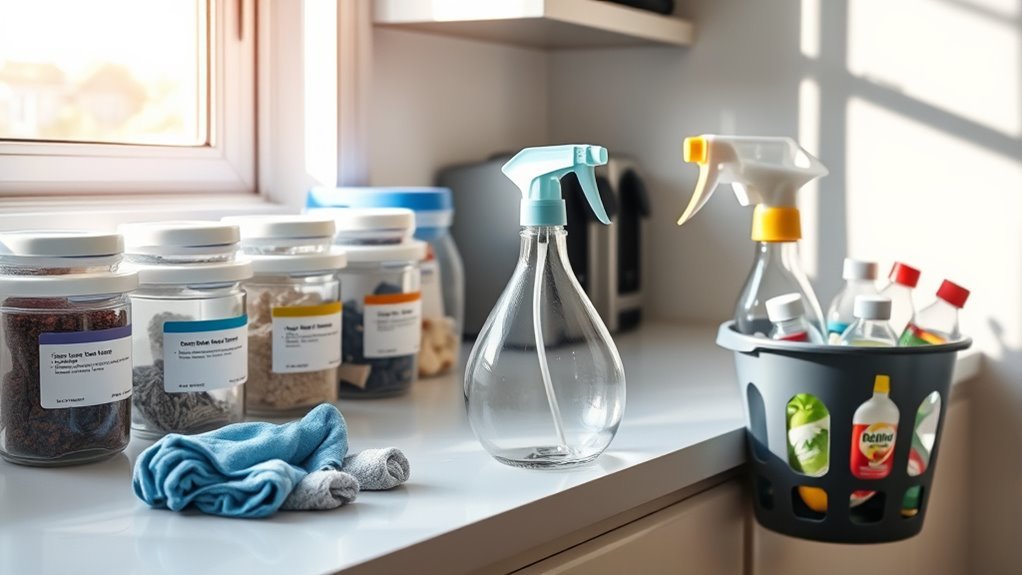
Once you’ve finished using hazardous chemicals, you need to clean up carefully to avoid spills, contamination, or exposure. Quick and proper action will protect your freedom to work safely without hazards lingering. Follow these essential cleanup techniques to manage any chemical spill effectively.
| Schritt | Action | Tipp |
|---|---|---|
| 1. Prepare | Wear PPE before cleanup | Gloves, goggles, mask |
| 2. Contain Spill | Use absorbent materials | Sand, kitty litter, or rags |
| 3. Collect | Scoop or sweep into disposal | Avoid dust or vapor release |
| 4. Clean Area | Wash surface with water & soap | Use minimal water to limit spread |
| 5. Ventilate | Air out the area thoroughly | Open windows or use fans |
Stick to these steps to keep your space safe and maintain your freedom from chemical hazards.
Proper Disposal Methods for Cleaning Chemical Residues
Before disposing of any cleaning chemical residues, you need to identify if they’re hazardous to handle them correctly. Make sure you’re familiar with your local disposal regulations to avoid fines or environmental harm. Always use safe containers designed for hazardous waste to prevent leaks and spills during transport.
Identifying Hazardous Residues
Although it might seem straightforward, identifying hazardous residues requires careful attention to the chemicals you’ve used and the materials they’ve come into contact with. You’ll want to apply effective residue identification techniques, like checking for discoloration, unusual odors, or sticky films. Understanding hazardous material characteristics—such as toxicity, flammability, or corrosiveness—helps you recognize what you’re dealing with. Don’t forget to review labels and safety data sheets to confirm residue risks. By accurately pinpointing hazardous residues, you keep your space safe while preserving your freedom to handle chemicals responsibly. Taking these steps guarantees you won’t mistakenly treat harmful leftovers like harmless waste, preventing potential harm to yourself and others. Always trust your instincts and knowledge when deciding how to proceed with any residue you find.
Local Disposal Regulations
Knowing how to spot hazardous residues is just the first step; you also need to handle their disposal correctly to avoid risks to people and the environment. When dealing with hazardous waste, you can’t just toss it out. Local disposal regulations exist to protect your community and natural spaces, so it’s vital to follow them. Check with your local waste management authority to find designated drop-off sites or scheduled collection events for hazardous waste. Never mix chemical residues with regular trash or pour them down drains, as this can cause contamination. By respecting local disposal rules, you maintain your freedom while ensuring safety for everyone around. Staying informed and responsible gives you control over your cleaning chemical waste and helps keep your environment clean and safe.
Safe Container Handling
Handling containers with hazardous cleaning chemical residues requires careful attention to avoid spills, exposure, or contamination. To keep things safe, always use containers made from safe container materials that won’t react with the chemicals inside. Glass, high-density polyethylene (HDPE), or specific plastics designed for chemical storage are your best bets. When you’re ready to dispose of any leftover residues, make sure to use proper container sealing methods—tight-fitting lids or heat sealing—to prevent leaks or fumes from escaping. Label containers clearly to avoid mix-ups, and never reuse containers for other purposes. Following these steps gives you the freedom to manage hazardous waste responsibly while protecting yourself and the environment. Remember, handling these materials with care isn’t just smart—it’s essential for your safety and peace of mind.
Guidelines for Storing Hazardous Chemicals at Home
You’ll want to use proper storage containers that are sturdy and clearly labeled to keep hazardous chemicals safe. Choosing the right location is just as important—pick a cool, dry place away from children and pets. Following these tips helps prevent accidents and keeps your home secure.
Proper Storage Containers
Choosing the right containers is essential when storing hazardous cleaning chemicals at home. You want containers that guarantee safety but also align with your eco-friendly values. Look for eco friendly containers made from durable, non-reactive materials to prevent leaks or spills. Always consider chemical compatibility; some substances can corrode or degrade certain plastics or metals. Avoid using old food jars or unlabelled bottles, as cross-contamination is risky. Clear labeling is key, so you know exactly what’s inside without guessing. Opt for containers with secure, childproof lids for added protection. By selecting proper storage containers, you maintain control over your space and reduce environmental impact. This way, you keep your home safe while honoring your freedom to choose responsibly.
Location Safety Tips
Although hazardous cleaning chemicals are necessary for keeping your home spotless, storing them safely is just as essential. You want to choose chemical storage locations that are cool, dry, and well-ventilated, away from direct sunlight or heat sources. Keep them out of reach of children and pets, ideally in locked cabinets or high shelves. Clearly mark these areas with hazardous area signage to remind everyone of the potential dangers and discourage unauthorized access. Avoid storing incompatible chemicals together to prevent reactions. Remember, a safe storage spot not only protects your household but also grants you peace of mind and freedom from worry. By following these location safety tips, you take control, ensuring your cleaning routine is both effective and secure.
Labeling and Organizing Chemical Storage Areas
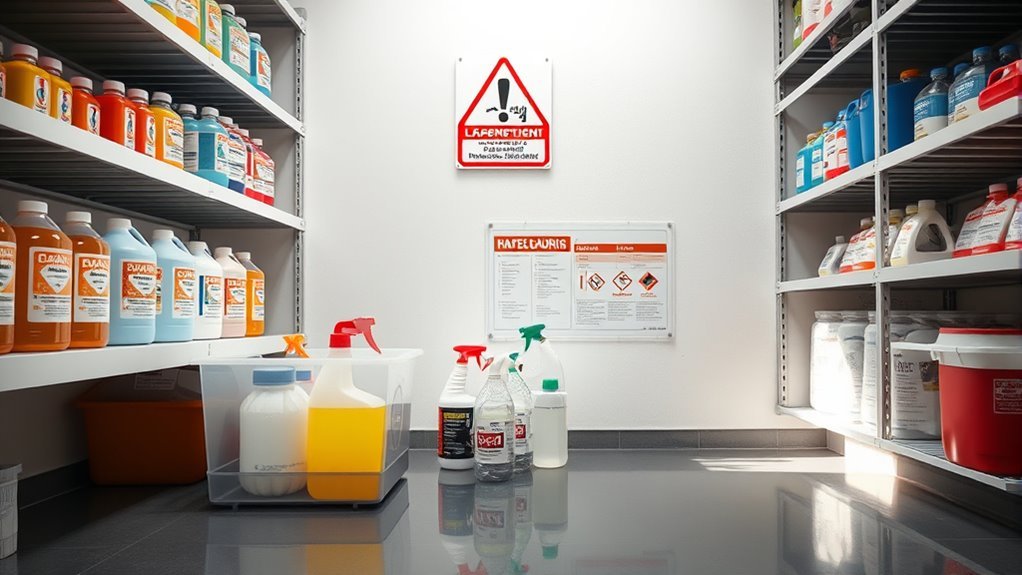
When handling hazardous cleaning chemicals, clear labeling and systematic organization of storage areas are essential to prevent accidents and guarantee quick access. You want to make sure every container has proper chemical labeling—this means including the chemical name, hazards, and handling instructions. It’s about staying safe while keeping things simple. For storage organization, group chemicals by type and hazard class, so you can find what you need without hassle. Use shelves or cabinets that are sturdy and well-ventilated, and avoid overcrowding to reduce the risk of spills or confusion. Keeping your chemical storage area organized not only boosts safety but also grants you the freedom to work efficiently without second-guessing what’s inside each container.
Preventing Chemical Reactions During Storage
To prevent dangerous chemical reactions, you need to keep incompatible chemicals apart and store them in proper containers designed for their specific properties. Make sure the storage area maintains a stable temperature to avoid triggering reactions. Taking these steps helps keep you and your workspace safe.
Separate Incompatible Chemicals
Storing hazardous cleaning chemicals safely means keeping incompatible substances apart to prevent dangerous reactions. When you understand chemical compatibility, you can design smart storage strategies that protect you and your space. For example, acids should never be stored near bases, and oxidizers must be separated from flammables. By grouping chemicals based on their properties and hazards, you reduce risks dramatically. Use clear labels and dedicated shelves or cabinets to keep incompatible items isolated. This approach not only prevents accidental mixing but also gives you freedom to work without constant worry. Remember, a well-planned storage system respecting chemical compatibility is your best defense against unexpected reactions and spills. Stay organized, stay safe, and maintain control over your hazardous materials.
Use Proper Containers
Although keeping chemicals separated is essential, you also need to use proper containers to prevent reactions during storage. Choosing containers made from chemical resistant materials is vital—they won’t break down or react with the hazardous substances inside. You don’t have to sacrifice safety for sustainability; eco friendly containers designed specifically for chemical storage are available and effective. These containers help you maintain control, ensuring nothing leaks or mixes unexpectedly. Always check compatibility between the chemical and the container material before storing. Properly sealed containers protect both you and the environment, giving you the freedom to handle hazardous cleaning chemicals without worry. By investing in the right containers, you’re not just storing chemicals—you’re safeguarding your space and peace of mind.
Maintain Stable Temperature
When you keep hazardous cleaning chemicals at a stable temperature, you reduce the risk of dangerous reactions caused by heat or cold. Temperature control is key to preserving their integrity and preventing unexpected hazards. You want a storage environment that avoids extreme fluctuations—no scorching heat or freezing chills. Aim for a cool, dry spot away from direct sunlight and heating vents. This helps chemicals stay stable and safe. If your storage space tends to swing in temperature, consider using climate control tools like thermostats or insulated cabinets. By maintaining a consistent temperature, you’re not just protecting the chemicals; you’re safeguarding yourself and your space. Taking control of the storage environment gives you the freedom to use chemicals confidently and responsibly.
Ventilation Requirements for Chemical Storage Spaces
Because hazardous chemicals can release harmful fumes, ensuring proper ventilation in storage spaces is essential for your safety. You want to install reliable ventilation systems that promote continuous air circulation, preventing the buildup of toxic vapors. Good airflow keeps the environment fresh and reduces the risk of inhaling dangerous gases, giving you the freedom to work confidently around these substances. Make sure your storage area has vents or fans that draw fresh air in and push contaminated air out efficiently. Avoid airtight rooms where fumes can accumulate; instead, design your space to allow natural or mechanical air movement. By prioritizing ventilation, you’re not just protecting yourself—you’re creating a safer, more breathable space that respects your right to a hazard-free environment.
Emergency Procedures for Chemical Spills and Exposure
Spills and exposure to hazardous chemicals demand immediate and well-coordinated action to minimize harm. When a spill occurs, your priority is quick spill response: contain the area, use proper protective gear, and clean up with suitable materials. If exposure happens, start exposure treatment immediately—remove contaminated clothing, rinse affected skin or eyes with water, and seek medical help if needed. Staying calm and following clear steps lets you act with the freedom to protect yourself and others effectively.
| Situation | Immediate Action |
|---|---|
| Chemical Spill | Contain spill, wear PPE, clean up |
| Skin Exposure | Rinse skin, remove clothing |
| Eye Exposure | Flush eyes for 15 mins, get help |
Regular Inspection and Maintenance of Chemical Storage Containers
To keep hazardous chemicals safe and prevent accidents, you need to regularly inspect and maintain their storage containers. Regular inspections help you spot leaks, corrosion, or damage early, avoiding spills that can restrict your freedom and safety. Check seals, labels, and structural integrity as part of your container maintenance routine. Replace worn or compromised containers immediately to guarantee no hazardous material escapes. Keeping containers clean and dry also extends their lifespan and safeguards your environment. By committing to these simple steps, you maintain control over your chemical storage without unnecessary risk. Remember, proactive container maintenance means fewer emergencies and more freedom to focus on what matters—using your chemicals safely and effectively. Don’t skip regular inspections; they’re your best defense against unexpected hazards.
Häufig gestellte Fragen
Can Hazardous Cleaning Chemicals Affect Indoor Air Quality Long-Term?
You might think hazardous cleaning chemicals could turn your home into a toxic wasteland, and in a way, they can. These substances often release volatile compounds that contribute to indoor pollution, seriously compromising your air quality over time. If you care about breathing freely and living without invisible chains, it’s essential to manage these chemicals wisely. Ignoring them can lock you into a cycle of poor indoor air quality and health risks.
How Do Temperature Fluctuations Impact Chemical Stability During Storage?
You’ve got to watch out for temperature extremes when storing chemicals because they can speed up or trigger unwanted chemical reactions. When temperatures swing wildly, it stresses the chemicals, making them less stable and potentially dangerous. Keeping them in a cool, steady environment helps maintain their integrity and keeps you safe. So, controlling temperature fluctuations isn’t just smart—it’s the key to freedom from unexpected hazards.
What Are Signs That Stored Chemicals Have Degraded or Become Unsafe?
You’ll want to watch for signs that your chemicals have degraded or become unsafe, like chemical discoloration—if the liquid’s color shifts unexpectedly, that’s a red flag. Also, notice any odor changes; if a familiar chemical suddenly smells stronger, sour, or just off, it’s a sign it’s breaking down. Trust your senses and instincts, because keeping your space safe means knowing when it’s time to dispose of those chemicals properly.
Are There Eco-Friendly Alternatives to Common Hazardous Cleaning Chemicals?
You’ll be glad to know there are plenty of eco friendly products that let you ditch harsh chemicals without sacrificing cleanliness. Green cleaning options like vinegar, baking soda, and plant-based detergents give you freedom from toxic substances while keeping your space fresh and safe. Choosing these alternatives not only protects your health but also the environment, so you’re making a smart, responsible choice that aligns with your values and lifestyle.
How to Safely Transport Hazardous Cleaning Chemicals Between Locations?
Transporting hazardous chemicals safely is both a challenge and a responsibility—you want freedom, yet safety demands care. Always use secure containers to prevent leaks or spills, and guarantee proper labeling so everyone knows exactly what’s inside. This careful balance lets you move your supplies confidently without risking harm or restrictions. Embrace the freedom of mobility, but never at the expense of safety; your precautions keep you and others protected on the go.
